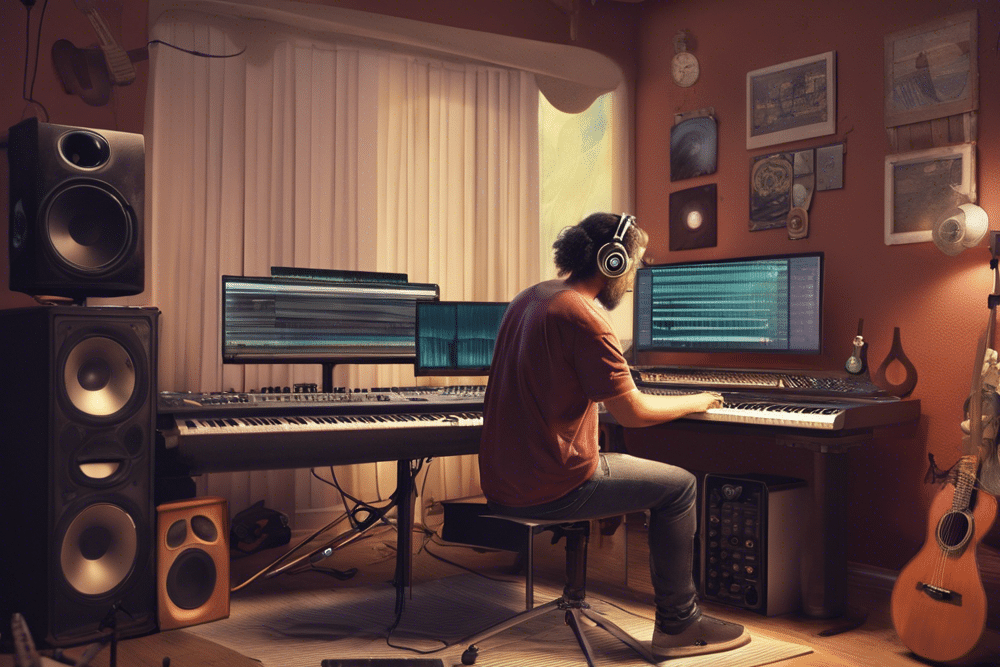Estimated reading time: 10 minutes
The Rise of a Sugary Sound
In the ever-evolving landscape of electronic music, a new genre has emerged that’s as colorful and playful as its name suggests. Bubblegum bass, also known as PC Music (after the record label that popularized it), has been making waves in the music industry with its unique blend of pop sensibilities and experimental electronic production. This genre is characterized by its bouncy rhythms, plastic-sounding synths, and often high-pitched vocals, creating a sound that’s both familiar and alien at the same time.
For music producers looking to expand their horizons or simply curious about the latest trends in electronic music, bubblegum bass offers a fascinating case study in genre evolution and production techniques. Let’s dive into the world of this sweet and sticky sound that’s reshaping the future of pop and dance music.
Table of contents
- The Rise of a Sugary Sound
- What Exactly is Bubblegum Bass?
- The Origins and Evolution of Bubblegum Bass
- Production Techniques in Bubblegum Bass
- Prominent Artists in the Bubblegum Bass Scene
- The Impact of Bubblegum Bass on the Wider Music Landscape
- Criticisms and Controversies
- The Future of Bubblegum Bass
- Video: Bubblegum Bass Tutorial In Ableton Operator
- Conclusion: The Sweet Sound of Innovation
- FAQs
What Exactly is Bubblegum Bass?
Bubblegum bass is a subgenre of electronic dance music that emerged in the early 2010s. It’s characterized by its use of exaggerated pop music tropes, combined with elements of various club sounds and experimental electronic production techniques. The result is a sound that’s simultaneously familiar and disorienting, often described as a “post-internet aesthetic.”
Key Elements of the Genre
- Bouncy, energetic rhythms
- Plastic-sounding, artificial synths
- High-pitched, often pitch-shifted vocals
- Extreme levels of processing and effects
- Wonky filters and unconventional sound design
- A mix of pop melodies and experimental structures
The genre takes its cues from various sources, including mainstream pop, hip-hop, trance, and even older genres like happy hardcore. However, it pushes these influences to their extremes, creating a sound that’s both a celebration and a deconstruction of pop music conventions.
The Origins and Evolution of Bubblegum Bass
Bubblegum bass didn’t just appear out of thin air. Its roots can be traced back to various electronic music movements and internet-born music fads of the late 2000s and early 2010s.
From Witch House to Wonky Pop
In the late 2000s, genres like witch house and seapunk were experimenting with the idea of internet-based aesthetics in music. These genres played with ideas of nostalgia, digital artifacts, and the blurring lines between online and offline culture. Bubblegum bass took these concepts and applied them to pop music structures, creating something entirely new.
The Birth of PC Music
The genre really began to take shape with the formation of PC Music, a London-based record label founded by producer A. G. Cook in 2013. PC Music released a series of singles and EPs that defined the bubblegum bass sound, featuring artists like Hannah Diamond, GFOTY, and Danny L Harle.
SOPHIE and the Mainstream Breakthrough
While PC Music was laying the groundwork, it was producer SOPHIE who really brought bubblegum bass to wider attention. Her 2013 single “Bipp” became an underground hit, showcasing the genre’s potential to create catchy, forward-thinking pop music. SOPHIE’s later work, including her album “OIL OF EVERY PEARL’S UN-INSIDES,” further pushed the boundaries of the genre and gained critical acclaim.
Production Techniques in Bubblegum Bass
For music producers, bubblegum bass offers a playground of innovative production techniques. Let’s break down some of the key elements that define the genre’s sound.
Synthetic Soundscapes
At the heart of bubblegum bass is its use of intensely artificial, plastic-sounding synths. Producers often use FM synthesis and wavetable synthesis to create these sounds, pushing them to extreme levels of brightness and artificiality.
Vocal Manipulation
Vocals in bubblegum bass are rarely left untouched. Pitch-shifting, formant manipulation, and extreme auto-tune effects are common, often pushing voices into uncanny valley territory. This can involve shifting vocals up to create childlike or alien-sounding voices, or down for a more monstrous effect.

Rhythm and Groove
While the genre is known for its bouncy, energetic rhythms, these are often created through unconventional means. Chopped and glitched samples, sporadic rhythmic changes, and unexpected pauses all contribute to the genre’s disorienting yet danceable grooves.
Extreme Processing
Bubblegum bass producers aren’t afraid to push effects to their limits. Heavy compression, distortion, and creative use of filters are all par for the course. The goal is often to create sounds that are simultaneously glossy and degraded, mirroring the aesthetics of low-quality internet media.
Software and Tools
Many bubblegum bass producers work primarily in-the-box, using DAWs like Ableton Live or FL Studio. Software synths like Serum, Massive, and FM8 are popular for creating the genre’s signature sounds. However, it’s not the tools themselves but how they’re used that defines the bubblegum bass sound.
Prominent Artists in the Bubblegum Bass Scene
While the genre started as a niche movement, it has since influenced and been adopted by a wide range of artists. Here are some key figures in the bubblegum bass world:
A. G. Cook
As the founder of PC Music and a prolific producer in his own right, A. G. Cook is often considered the godfather of bubblegum bass. His production work, both solo and for other artists, has been instrumental in defining the genre’s sound.
SOPHIE
SOPHIE’s innovative production techniques and boundary-pushing approach to pop music made her one of the most influential figures in electronic music. Her work ranged from underground club tracks to mainstream pop productions.
Charli XCX
While not exclusively a bubblegum bass artist, Charli XCX’s collaborations with PC Music producers helped bring the genre to a wider audience. Her mixtapes “Number 1 Angel” and “Pop 2” are considered classics of the genre.
Hannah Diamond
One of the original PC Music artists, Hannah Diamond’s pristine vocals and hyper-digital aesthetic embodied the label’s early sound.
100 gecs
This duo pushed bubblegum bass into new territories, blending it with elements of metal, ska, and other genres to create a chaotic yet catchy sound.
The Impact of Bubblegum Bass on the Wider Music Landscape
Bubblegum bass may have started as an underground movement, but its influence has spread far beyond its original niche. Let’s explore how this genre has impacted the broader music industry.
Influencing Mainstream Pop
Elements of bubblegum bass production have seeped into mainstream pop music. Artists like Charli XCX, Kim Petras, and even Madonna have incorporated bubblegum bass elements into their music, bringing its futuristic sound to a wider audience.
Redefining ‘Experimental’ Music
Bubblegum bass has challenged notions of what constitutes ‘experimental’ music. By applying avant-garde production techniques to pop structures, it’s created a new space for experimentation within popular music formats.

Internet Culture and Music
The genre’s close ties to internet culture and aesthetics have highlighted the growing importance of online communities in shaping musical trends. Bubblegum bass shows how genres can now emerge and evolve primarily through online interactions.
Production Techniques
Many of the production techniques pioneered by bubblegum bass producers have found their way into other genres. The use of extreme pitch-shifting, hyper-compressed sounds, and glitchy rhythms can now be heard across various styles of electronic and pop music.
Criticisms and Controversies
Like any innovative movement, bubblegum bass has faced its share of criticism and controversy.
Style Over Substance?
Some critics argue that bubblegum bass prioritizes novelty and shock value over musical substance. They see the genre’s extreme sounds and ironic approach to pop as more of a gimmick than a genuine musical movement.
Authenticity Debates
The genre’s play with artificiality and its deconstruction of pop tropes have led to debates about authenticity in music. Some see bubblegum bass as a critique of the manufactured nature of pop music, while others view it as an embrace of that artificiality.
Accessibility Issues
The extreme nature of many bubblegum bass tracks can make them challenging for casual listeners. This has led to debates about whether the genre is too niche or alienating for wider audiences.
The Future of Bubblegum Bass
As we look to the future, what can we expect from bubblegum bass? While predicting musical trends is always challenging, there are several possibilities to consider.
Continued Evolution
Like all genres, bubblegum bass is likely to continue evolving. We may see it splinter into various sub-genres or blend with other styles to create new hybrid sounds.
Mainstream Adoption
As more mainstream artists incorporate elements of bubblegum bass into their music, we might see a watered-down version of the genre gain wider popularity. This could lead to new, more accessible forms of the sound.
Influence on Production Techniques
Even if bubblegum bass as a distinct genre fades, its impact on production techniques is likely to be long-lasting. The innovative approaches to sound design and arrangement pioneered by bubblegum bass producers will continue to influence electronic music production.
Virtual and Augmented Reality
Given the genre’s close ties to digital culture, it’s possible that bubblegum bass could find new expression in emerging technologies like virtual and augmented reality. We might see immersive bubblegum bass experiences that blend music, visuals, and interactivity in new ways.
Video: Bubblegum Bass Tutorial In Ableton Operator
Conclusion: The Sweet Sound of Innovation
Bubblegum bass represents a unique moment in the evolution of electronic music. It’s a genre that celebrates the artificial and the extreme, pushing the boundaries of what pop music can be. For music producers, it offers a wealth of innovative techniques and approaches to explore.
Whether you’re looking to incorporate elements of bubblegum bass into your own productions or simply wanting to understand this fascinating genre, there’s no denying its impact on the contemporary music landscape. It’s a reminder that even in the well-established world of electronic music, there’s always room for something new, exciting, and deliciously strange.
As we move forward, bubblegum bass will likely continue to evolve and influence other genres. Its legacy of fearless experimentation and playful deconstruction of pop tropes will undoubtedly be felt in electronic music for years to come. So the next time you hear a pop song with impossibly high-pitched vocals or a beat that sounds like it’s been run through a digital blender, remember: you might just be hearing the sweet, sticky influence of bubblegum bass.
Related Posts
FAQs
Bubblegum bass is a subgenre of electronic dance music characterized by its playful and exaggerated use of pop music elements combined with experimental electronic production. It often features bouncy rhythms, artificial synths, and high-pitched vocals, creating a sound that is simultaneously familiar and surreal.
Bubblegum bass emerged in the early 2010s, influenced by internet-based music genres like witch house and seapunk. It gained prominence through the London-based record label PC Music, founded by A. G. Cook, and was further popularized by artists like SOPHIE and Hannah Diamond.
The genre is defined by energetic, bouncy rhythms, plastic-sounding synths, pitch-shifted vocals, and extreme processing techniques. It mixes pop melodies with experimental sound design, often using heavy compression, distortion, and unconventional filters to create a unique auditory experience.
Key figures include A. G. Cook, the founder of PC Music, and SOPHIE, whose innovative production brought the genre mainstream attention. Other notable artists include Hannah Diamond, Charli XCX, and the duo 100 gecs, all of whom have contributed to the genre’s evolution.
Bubblegum bass has influenced mainstream pop by introducing experimental production techniques and highlighting the role of internet culture in music. Its playful deconstruction of pop tropes has also sparked debates about authenticity and the nature of experimental music in popular culture.
